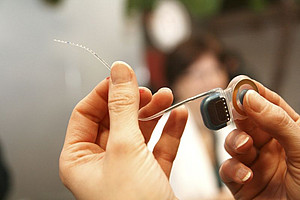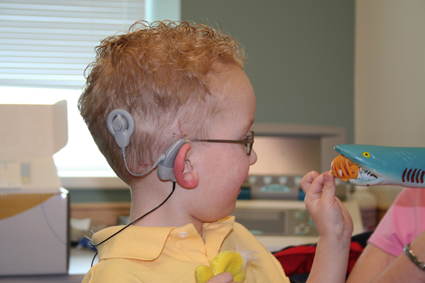Providing hearing – the cochlear-implant for the hard at hearing
According to the University Hospital of Texas Medical Center, 324,000 people who were suffering from severe hearing problems, profited from cochlear implants in 2012. The German Cochlear Implant Society reported that they have made around 30,000 implants in Germany. They are also known as inner ear implants and are electrical stimulation devices for the hearing auger (Latin cochlea). The implants are surgically inserted into the skull of the patients and are connected to a hearing aid worn on the outside of the skull. The electrical pulse generator replaces the functionally disturbed hair cell receptors in the inner ear, and the cochlea transmits the impulses to the brain areas that are responsible for the processing of hearing signals.
These implants, which in many cases provide babies that were deaf with the ability to hear and speak, were developed in experiments with cats and guinea pigs. Cats were the main model because on the one hand, they are equipped with particularly sensitive hearing senses and on the other hand, they have a hearing system is anatomically very similar to that of humans. The necessity for cats and guinea pigs in this model came about because their frequency range is similar to that of humans. The experiments proved that the electrical stimulation of the auditory nerve works and the connected brain regions are able to reorganize themselves through the stimulation. The detailed understanding of the structure and function of the hearing auger is also based on basic research in animal experiments.
A direct stimulation of the human auditory nerve with electrical signals was for the first time achieved in 1957 by the scientists André Djourno and Charles Eyriès in Paris. In as early as 1964, Dr. F. Blair Simmons attempted an operation with a human volunteer, but encountered problems and continued to work on animal experiments to define among other things, the surgical approach and the ideal number of electrodes.
Thanks to the animal experiment findings, the first two multichannel processors were implanted in humans at the end of the 1970s. This enabled patients to understand the spoken language for the first time. In the middle of the 1980s the doctors Ernst Lehnhardt and Roland Laszig brought the cochlear implant to Germany for everyday use. The first child to receive the implant was a girl in 1986. Nowadays, the operation is a low-risk routine intervention and is easy to perform, even on infants. The implant can help to teach speech comprehension to children that were born deaf (according to the "Focus", approximately 3 out of 1000 children are born with such severe hearing problems).
This video, created by Advanced Bionics, explains how a cochlear implant works.
With optical stimulation to more quality in hearing

There are limitations to the development of the electrical stimulation of the hearing aid: The electrode contacts of the implant in the saline solution of the hearing aid, spread a current to address the nerve cells, this means that patients cannot hear exact frequencies accurately. Result: The patients have problems distinguishing different sound pitches, have difficulty listening to melodies and listening to speech through noise.
Neurological adaptation to the perception and an intensive, long-lasting hearing after the operation can somewhat reduce the problems, but not fix them. The head of the InnerEarLab at the University of Göttingen and a Research Group at the DPZ, Tobias Moser wants to tackle the problem with a focus on irritation of the nerve cells through optical stimuli. This form of research is called "optogenetics". The cells, that will be visually irritated, must first be "rebuilt" genetically. In this area of research, animal experiments with primates are also necessary.
In preliminary experiments on rodents, the team of Tobias Moser has succeeded to irritate the sense of hearing through light signals instead of electric current. He will now set his research forth with common marmosets (Callithrix jacchus): on the one hand, it must be checked whether the genetic modification of neurons is safe for primates, on the other hand, the communication methods of monkeys are similar to that of humans and therefore a comparison of the effectiveness of both implants is only possible with this model.


